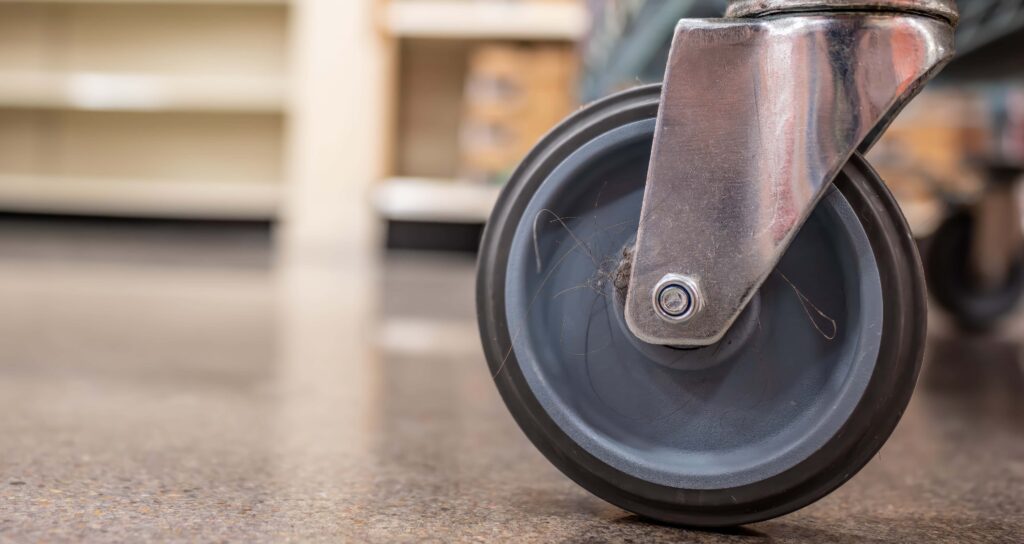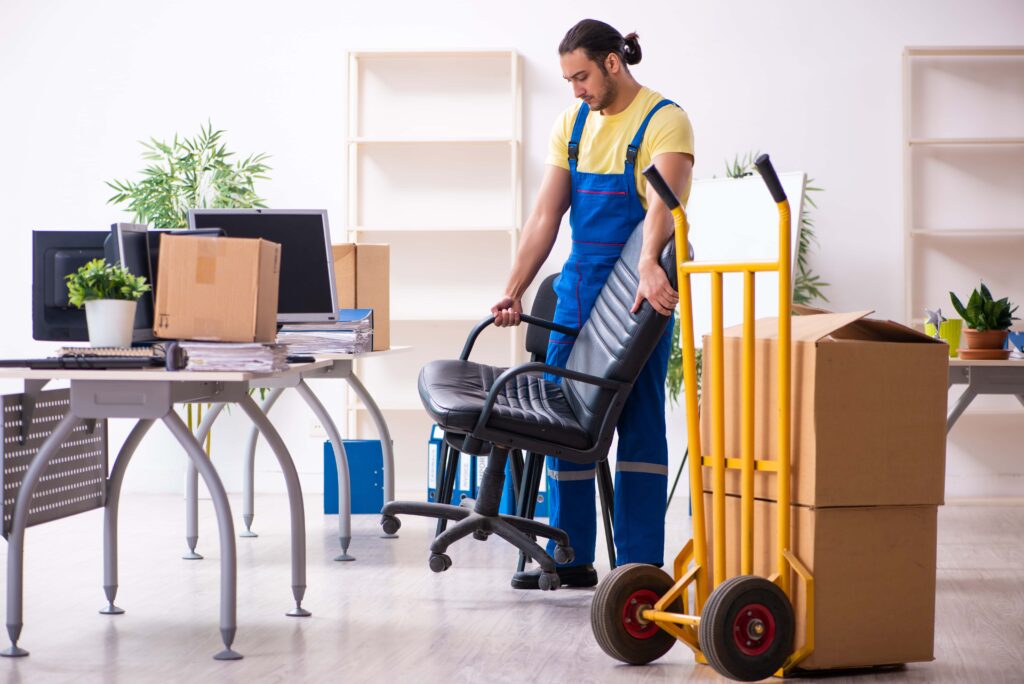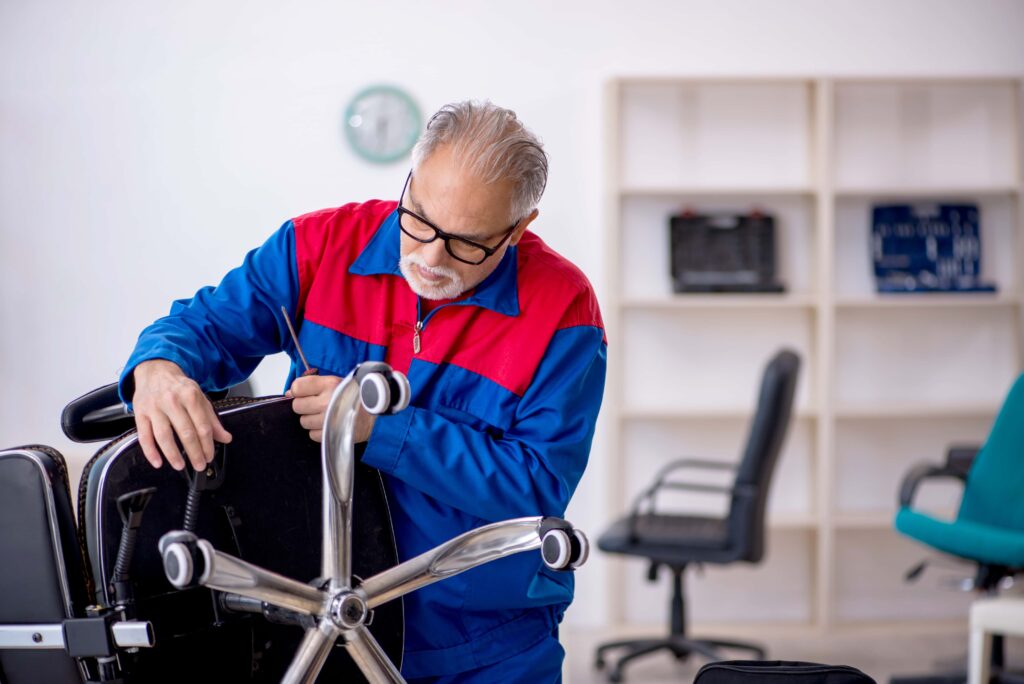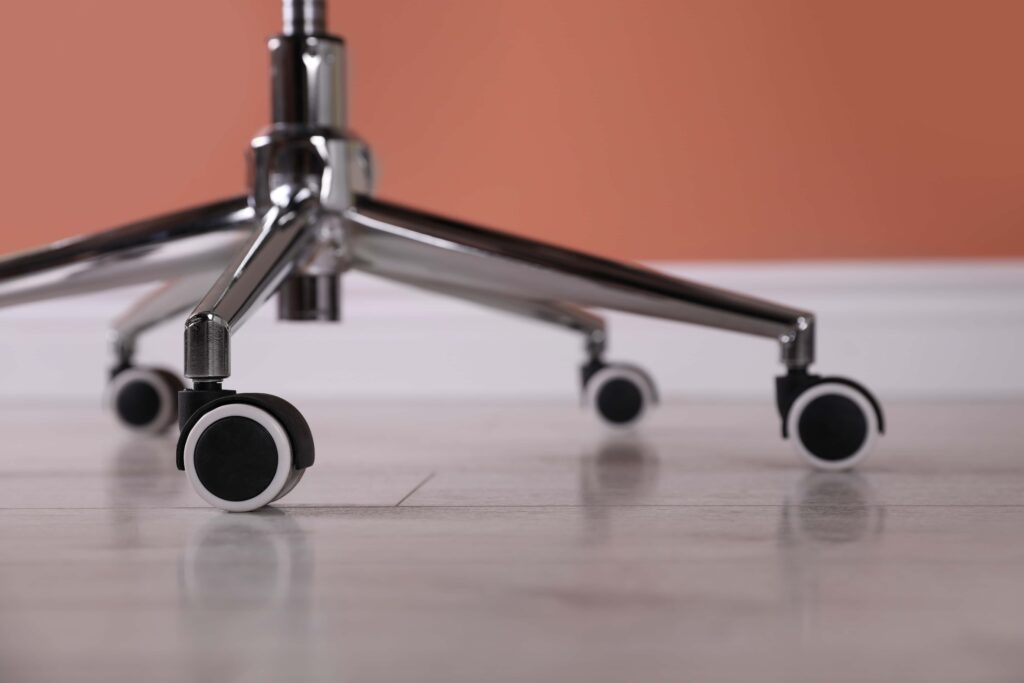How to Clean Office Chair Wheels?
As you sit at your desk, quill in hand, you can’t help but notice your modern throne on wheels isn’t rolling as majestically as it should. It’s time to give your office chair wheels the royal treatment they deserve.
You’ll need to clear out the pesky debris and detritus that’s cramping their style. In this guide, you’ll discover how to efficiently clean your chair’s wheels, ensuring they glide as smoothly as a scribe’s pen across parchment.
Grab your cleaning supplies, and let’s dive into the simple yet effective steps to banish the grime from your chariot’s rollers.
You’ll not only reclaim the seamless movement of your chair but also prolong its life, making your daily toil at the desk a bit more bearable.
Ready? Let’s get those wheels spinning like new, using this help advice of the best provider of office cleaning services in Stamford.

Assessing Office Chair Wheel Condition Before Cleaning
Before you begin cleaning, take a moment to inspect your chair’s wheels for visible damage, such as cracks or breaks in the material, which could affect their functionality.
Test the mobility of the wheels by spinning and rolling them to check for any resistance or unusual noises indicating a deeper problem.
Lastly, assess the level of debris accumulation, focusing on hair and threads that might be entangled within the wheel mechanism, as this can hinder smooth movement.
Visible Damage Inspection
During your cleaning process, it’s crucial to check for any visible damage on the wheels to ensure they’re still in working order. Carefully inspect each wheel for signs of wear or breakage.
If there’s visible accumulation of dirt and debris, use a scrub brush to remove these impurities effectively. Pay particular attention to hair tangled around the axle which can impair the wheel’s rotation. Use the appropriate tools to remove hair and avoid cutting into the wheel material.
This careful inspection prevents overlooking any potential issues that could compromise the chair’s mobility or your safety. Remember, maintaining the wheels not only extends their life but also ensures a smoother ride.
Mobility Functionality Check
After cleaning your office chair wheels, you’ll need to check their mobility to ensure they’re rolling smoothly and haven’t sustained any damage. Here’s how to assess their condition:
Chair Rolling Smoothly
- Spin each wheel by hand; it should rotate freely.
- Roll the chair on a flat surface; it should move without resistance.
Wheels Sticking
- Identify any wheels that don’t turn or have restricted movement.
- Apply a silicone lubricant to plastic chair casters.
- For wheels with metal components, use a greaseless lubricant.
Ensure that no debris is lodged in the casters. If the wheels are still not moving freely after lubrication, they might require repair or replacement to restore full mobility.
Debris Accumulation Assessment
Assessing your chair’s wheel condition after cleaning involves checking for any remaining debris that could hinder smooth movement. You’ll need to conduct a thorough debris accumulation assessment to ensure nothing is left that can impede the wheels’ function.
Start by visually inspecting the wheels for stuck debris. If you notice small pieces of debris, use tweezers or a butter knife to delicately remove them. Ensure that the clean caster wheels are free from any obstructions.
Rotate each wheel manually to detect if any unseen debris is present. Should you find resistance, it might indicate that more cleaning is needed. Removing all debris is crucial to maintain your office chair’s mobility and prolong the life of the caster wheels.
Cleaning Supplies to Clean Office Chair Wheels
Before you begin, it’s essential to select the appropriate tools for the job. These may include a scrub brush, tweezers, and a butter knife. You’ll also want to prepare a soapy solution—consider eco-friendly options—and ensure you have protective gear like gloves.
Organize your supplies efficiently to streamline the cleaning process and prevent any interruptions.
Select Appropriate Tools
Always start by gathering the essential tools you’ll need to effectively clean your office chair wheels. A detail-oriented approach ensures you won’t miss any debris that could hinder the chair’s movement.
Here’s a breakdown of the supplies you should have on hand:
For removing tangled hair and threads:
- Pliers or tweezers: Ideal for precision grip
- Crochet hook: Useful for pulling out stubborn entanglements
For dislodging and scraping debris:
- Butter knife: Gently scrapes without damaging the wheels
- Vacuum with a brush attachment: Sucks up loose dirt and dust
Ensure you have these tools ready before you start the cleaning process to make the task as efficient as possible.
Consider Eco-Friendly Options
Gathering your cleaning supplies, opt for eco-friendly choices that’ll effectively clean your office chair wheels without harming the environment.
Begin by preparing a soapy water solution with just a few drops of dish soap — a simple yet powerful concoction to tackle grime.
During the cleaning process, scrub the wheels with a reusable brush to remove dirt embedded in the crevices.
If you need to disinfect, use rubbing alcohol instead of harsh chemicals. It’s non-toxic and will leave your wheels dry and sanitized.
For a final touch, choose a silicone lubricant for any plastic wheels. It’s a greener option that ensures smooth motion and extends the lifespan of the wheels.
Prepare Soapy Solution
While you collect your cleaning supplies, mix a cup of water with 2-3 drops of dish soap to create an effective soapy solution for your office chair wheels. This solution will help you clean the wheels thoroughly, ensuring that you remove all the dirt and grime that can accumulate on the casters.
Here’s a quick guide to preparing your cleaning arsenal:
Gathering Cleaning Supplies
Essential tools:
- Butter knife
- Scrub brush
Cleaning agents:
- Soapy solution (water + dish soap)
- Rubbing alcohol for disinfection
Use the butter knife to scrape off any stuck debris from the wheels. Then, employ the scrub brush with the soapy solution to clean the wheels from the chair. Lastly, sanitize with rubbing alcohol for a comprehensive clean.
Ensure Protective Gear
How about keeping your hands safe during the cleaning process?
To thoroughly clean your rolling office chair’s wheels, you’ll want to gather the right supplies without neglecting your safety. Before you start, put on a pair of durable gloves to protect your skin from dirt and potential irritants.
As caster wheels are made to withstand daily use, they can accumulate a stubborn mix of dust and debris. You’ll need tools like a butter knife, a scrub brush, and tweezers to effectively dislodge and remove this gunk.
While you’re at it, use a vacuum with a brush attachment to suck up loose particles. This step is key before you move on to cleaning the wheels with your soapy solution and rubbing alcohol.
Organize Supplies Efficiently
Before diving into the task of cleaning your office chair wheels, make sure you’ve got all your supplies neatly arranged and within reach. Organizing your cleaning supplies efficiently will prevent interruptions and streamline the cleaning process.
Here’s what you need to have on hand:
Cleaning Tools:
- Butter knife or flat-head tool to scrape off debris
- Tweezers to remove hair and pull out threads
- Scrub brush to use a brush on stubborn dirt
Cleaning Agents and Materials:
- Cotton swabs or Q-tips for crevices
- Disinfectant like rubbing alcohol for a thorough cleanse
- Old towel or blanket to protect the chair
With everything in place, you can focus on getting those casters clean without the hassle of searching for tools mid-task.

Preparing Work Area for Office Chair Wheels Cleaning
To prepare your work area for cleaning office chair wheels, follow these steps:
- Lay a towel or drop cloth on the floor to protect it from dirt and debris. This precaution not only keeps your space tidy but also prevents any small components from rolling away or getting lost during the cleaning process.
- Before you start, ensure you have all the necessary tools within reach to avoid interruptions. You’ll need to remove the wheels without causing damage; therefore, keep the right tools handy—typically, a screwdriver or a lever, depending on your chair’s design.
- If you plan to work on each wheel individually, which is highly recommended, set up separate areas for the wheels already cleaned and those awaiting attention.
- When preparing your work area, consider the possibility of stubborn grime that may require additional cleaning agents. It’s best to keep these solutions nearby, along with a disposal method for any dirty substances removed from the wheels. Since you’ll be handling the set of wheels and might encounter challenging dirt, wearing gloves can protect your hands and maintain hygiene.
- As you get ready to clean, remember that you may not need to remove all the wheels from the chair. Sometimes, cleaning can be done with the wheels attached. However, if a deeper clean is necessary, be prepared with a secure place to store the screws or clips you remove.
With your work area set, you’re now ready to proceed to the next step—cleaning the wheels to ensure they roll smoothly and your office chair remains in top-notch condition.

Office Chair Wheel Removal Process
Before you start the wheel removal process, flip your chair upside-down and place it on a protective layer to safeguard your floor.
You’ll need to locate the wheel attachments—these may be clips or screws—and then carefully pry the wheels off using the appropriate tools.
If your chair has a twist-off mechanism, rotate the wheels counterclockwise until they detach.
Flip Chair Upside-Down
You’ll need to flip the chair upside down to access and remove the wheels for cleaning. Take care to protect your floor by laying down a sheet or towel before you begin.
Here’s how to proceed:
Prepare the Area and Chair
- Place a protective sheet underneath the chair
- Carefully flip the chair upside, ensuring stability
Wheel Removal Process
- Identify how the wheels are attached (snap-on or screw-in)
- For snap-on wheels, apply gentle pressure to pop them off
- For screw-in wheels, use a tool to remove the screws
- Use tweezers to remove any hair and debris caught in the wheels’ assembly
Remember to keep all screws and small parts in a container to avoid losing them.
Protect Floor First
Ensure your floor is shielded from potential scuffs and scratches by placing a drop cloth or plastic sheeting underneath the chair before you begin the wheel removal process. In an office where a rolling office chair is a staple, it’s vital to protect the floor first to maintain the pristine condition of your workspace.
When you’re ready to clean, flip the chair over carefully, ensuring the wheels glide smoothly onto the protective layer.
Consider using a chair mat in high-traffic areas to minimize wear and tear on your flooring. This proactive measure not only facilitates easier cleaning but also extends the life of both your floors and chair wheels.
Locate Wheel Attachments
To begin the wheel removal process, first identify the type of attachment that secures your chair’s wheels in place, which can vary depending on the chair’s make and model. Here’s a breakdown of what you should look for:
Check for Wheel Cover and Attachments:
- Inspect the area around the wheel for a cover or plate that might be hiding screws or clips.
- If present, carefully remove the wheel cover using a screwdriver to expose the attachment mechanism.
Removing the Wheels:
- Locate any screws that secure the wheels and keep them in a safe place after removal.
- Gently remove the plastic wheels by pulling or prying them off as appropriate.
- Once clean, you’ll be able to pop the wheels back on or screw them firmly into place.
Pry Wheels Carefully
When you’re ready to remove your chair’s wheels, gently pry them off with the appropriate tool, taking care not to damage any parts.
Whether your chair has soft or hard caster wheels, you’ll likely need a screwdriver to initiate the removal process. Start by examining the wheel to locate the attachment point. If there’s a visible screw, use your screwdriver to loosen it.
For models without a screw, fit the flat end of the screwdriver at the base of the wheel and carefully apply leverage. Pry wheels carefully to avoid bending or snapping the casters. Once loosened, pull the wheel straight out from the socket.
Keep all screws and removed parts in a safe place to ensure easy reassembly after cleaning.
Twist-Off Method
After prying off any stubborn wheels with a tool, you can often twist off the remaining ones by hand, providing a quicker and simpler way to detach them for cleaning. The twist-off method is straightforward and effective for most office chair models. Here’s what you need to do:
Twist-Off Method:
- Grasp the wheel firmly with your hand.
- Apply steady, gentle pressure and twist the wheel counterclockwise.
*Note:*
- Some wheels may have a locking mechanism; disengage it before twisting.
- If the wheel resists, check for any clips or notches that might be securing it in place.
Once loose, pull the wheel away from the chair to remove it.
Continue with the other wheels until all are ready to clean.
Keep Screws Safe
Once you’ve twisted off the wheels, it’s crucial to keep the screws in a secure place to avoid losing them during the cleaning process. As you remove each wheel from your chair using a screwdriver, immediately place the corresponding screws in a small container or a magnetic parts tray. This ensures they’re safe and readily available for reassembly.
It’s important to be methodical and organized, as even one missing screw can compromise the stability of your chair. Remember, the screws are essential for securely attaching the wheels back onto the chair once they’re clean. Take care not to misplace them, and double-check that all screws are accounted for before you proceed with cleaning the wheels.
Wheel Detachment Methods
Having secured your screws in a safe place, you’ll now need to remove the wheels from your chair. There are two methods you can use for wheel detachment: pressing the release button or using a pry tool.
To remove the wheels by pressing the release button, start by locating the button or lever typically found on the base near the wheel. Once you’ve found it, press or slide it to release each wheel.
If you prefer to use a pry tool, begin by sliding the pry tool or a flat-head screwdriver under the wheel. Be careful as you apply pressure to pop the wheel out, making sure not to damage the base.
Both of these methods will allow you to remove the wheels, giving you access to clean inside the wheel housings and tackle the tough spots between two wheels.
Reattach Wheels Securely
Before you flip your chair back upright, ensure each wheel is snapped firmly into place to avoid any wobbles or mishaps.
To reattach wheels securely, align each wheel with the socket on your chair’s base. Press down firmly until you hear a click or feel the wheel lock into position.
Check the fit by tugging gently on the wheel to ensure it won’t come loose. If your chair’s design includes screws, replace them now, tightening around the wheel cover for a snug fit.
Once you’ve put the wheels back, give each one a spin to confirm they move freely. Doing this assures that you’ve reconnected the wheels properly, and your chair is ready for use.
Deep Cleaning Office Chair Wheels
While you’re tackling the task of cleaning your office chair wheels, don’t forget to give them a deep clean by soaking them in soapy water to loosen the stubborn grime before scrubbing. This deep cleaning wheels process ensures that you remove all the accumulated dirt and debris that regular cleaning might miss.
Here’s a detailed subsectionstep guide to deep cleaning your office chair wheels:
Prepare for Deep Cleaning
- Remove wheels from the chair.
- Prepare a mixture of warm soapy water.
Soaking and Scrubbing
- Soak the wheels in the soapy solution for at least 10 minutes.
- Use a scrub brush to clean the surface of each wheel.
- For tight spots, use a toothbrush or cotton swabs.
After soaking, it’s crucial to tackle the hair and fibers that might be wrapped around the wheel’s axle. Use a crochet hook or tweezers to pull these out. Once you’ve managed to remove all visible debris and hair, give the wheels another scrub to ensure they’re thoroughly clean.
Once the office chair wheels are free of grime, rinse them with clean water and dry them completely before reattaching them to your chair. Remember, moisture can cause damage, so make sure they’re absolutely dry.
Finally, apply a spray lubricant to the inside of each wheel, wiping off any excess to prevent future dirt accumulation. This protective measure helps maintain the wheels’ smooth movement and extends their lifespan.
Deep cleaning your office chair wheels might seem like a hassle, but it’s a vital maintenance step that keeps your chair rolling smoothly and efficiently.
Caring for Office Chair Wheel Covers
Your office chair’s wheel covers require as much attention as the wheels themselves, so start by wiping them with a cloth dampened in kitchen cleaner or rubbing alcohol. This initial step helps to remove the surface grime and prepares the covers for a more thorough cleaning. As you’re caring for your chair, remember that cleanliness extends to every part, including these often-overlooked areas.
To clean the inside of the wheel covers, use cotton swabs or Q-tips. These tools are perfect for reaching into the narrow crevices where dust and hair tend to accumulate. Gently swab around the inside, ensuring you remove as much debris as possible. If you encounter hair or fibers tightly wound around the wheel cover, carefully use a crochet hook to tease them out. This method prevents pulling or straining on the cover, which could cause damage.
In cases where gunk is stubborn and hard to remove, soaking the wheels may be necessary. Detach the wheel covers from your office chair if possible, and let them soak in a solution of warm water and mild detergent. This will help loosen the dirt, making it easier to scrub away afterward. Once soaked, use a soft-bristled brush to gently scrub the covers clean.
After cleaning, it’s crucial to dry each wheel cover thoroughly. Residual moisture can lead to issues such as rust or mold growth, especially if the covers are made from materials susceptible to water damage. Use a dry towel to pat them down or leave them out to air dry before reattaching them to the chair.
Regular maintenance of your office chair’s wheel covers will ensure they remain in good condition, contributing to the overall longevity and functionality of your chair.
Lubrication and Maintenance for Smooth Chair Wheels
After thoroughly cleaning your office chair wheels, selecting the right lubricant is crucial for maintaining smooth operation.
You’ll need to apply it carefully, ensuring you cover the internal moving parts without over-lubricating.
Once you’ve completed the lubrication, it’s important to wipe away any excess to prevent dirt from sticking and to keep your wheels rolling effortlessly.
Selecting Proper Lubricant
Once you’ve cleaned the office chair wheels, it’s crucial to select the right lubricant to keep them rolling smoothly. Here’s what you need to know:
Spray Lubricants
- Ideal for penetrating small spaces
Greaseless Lubricants
- Best for metal-to-metal contact
- Prevents dirt buildup
Silicone Lubricants
- Excellent for all-plastic wheels
Maintenance Tips
- Apply sparingly to avoid excess
- Wipe away any excess with a piece of duct tape
Let us emphasize the importance of lubrication—it’s the hidden upside to a well-maintained chair. Proper lubrication will fit inside the wheel mechanism seamlessly and keep your chair rolling without hitches. Always apply with precision and care to maintain optimal performance.
Lubrication Application Techniques
All cleaned up, you’ll need just a few drops of the right lubricant to ensure your office chair wheels glide smoothly. Depending on the type of chair you have, the lubrication application techniques will vary.
For metal-to-metal contact, you’ll need to use a greaseless lubricant. Carefully apply it to the axle or pivot point and gently rotate the wheel to distribute the lubricant evenly.
For all-plastic wheels, consider using a silicone-based lubricant. Remove the wheel from the chair if possible to access the bearing area. A precise application will prevent any excess from attracting dirt, which could impede the wheel’s motion.
Once applied, reattach the wheels securely and test their movement to ensure maintenance is complete.
Post-Lubrication Wheel Care
You’ll want to ensure your office chair wheels remain in top condition after lubrication by adopting a regular maintenance routine. This routine not only helps in preserving the smooth operation of the wheels but also extends their lifespan.
Here’s how to keep them rolling effortlessly:
Regular Maintenance:
- Inspect wheels monthly for debris and clean as needed.
- Wipe off excess lubricant to prevent build-up.
Detailed Care:
- Check for smaller particles trapped inside the wheel housing.
- Address any subsection of the wheel that seems to underperform.
Reassembling Office Chair Wheels
Once your chair wheels are clean and dry, it’s time to focus on reassembling them correctly.
First, ensure each wheel is aligned properly before securing it back onto the chair to guarantee smooth rolling.
After they’re attached, apply the appropriate lubricant and test the rotation to prevent future clogs and maintain optimal performance.
Correct Wheel Alignment
Having cleaned and lubricated your office chair wheels, it’s crucial to align them correctly when reassembling to ensure the chair rolls smoothly and maintains its stability. Follow these detailed steps:
Check Alignment:
- Ensure the wheels are facing the right direction.
- Verify that each wheel is at the correct angle.
Secure Wheels:
- Put the wheels back onto the chair.
- Tighten any screws or bolts around the wheel housing.
Secure Attachment Methods
After cleaning your office chair’s wheels, you’ll need to reattach them securely to ensure smooth rolling and stable support.
Begin by aligning the stem of each wheel with the socket on the chair base. Press firmly until you hear a click, indicating the wheel is locked in place.
For wheels that screw on, use the appropriate tool to tighten them, ensuring they’re snug but not over-tightened, which can strip the threads.
Apply a silicone lubricant to all-plastic wheels for unimpeded movement.
If a wheel resists easy attachment, a gentle tap with a hammer or the use of a clamp can aid in securing it without damaging the components.
Double-check each wheel for secure attachment before resuming use of the chair.
Lubrication After Assembly
You’ll need to lubricate the wheels once they’re back in place to ensure your chair rolls smoothly. Proper lubrication is crucial for effortless movement and to reduce wear on the components. Here’s how to do it:
Choose the right lubricant:
- For metal-to-metal contact, opt for a greaseless lubricant.
- For all-plastic wheels, a silicone lubricant is best.
Apply the lubricant:
- Spray inside each wheel hub.
- Wipe away any excess to prevent dirt buildup.
After lubricating, reattach the wheels by either popping them back onto the chair base or screwing them in, depending on the design of your chair. This step is essential for maintaining the longevity and performance of your office chair wheels.
Testing Wheel Rotation
Once you’ve reattached the wheels, it’s crucial to test their rotation to ensure they’re operating smoothly. To do this, gently roll the chair on a flat surface, watching for any hitches or resistance.
Each wheel should turn freely without sticking. If you notice a wheel that isn’t moving as it should, remove it again and check for any remaining debris or misalignment. Apply additional lubricant if necessary, but remember to wipe away excess to prevent attracting more dirt.
After adjustments, retest the wheels to confirm they all exhibit an effortless glide. This careful attention to detail guarantees your chair’s mobility and extends the lifespan of the casters.
Prevent Future Clogs
Prevention is key to ensuring your chair’s wheels remain free of clogs after you’ve reassembled them. Proper maintenance minimizes the need for frequent disassembly and extends the life of the wheels. Follow these steps:
- Regularly inspect wheels for accumulated debris
- Use a brush or cloth to remove surface dirt.
- Check for entangled hair or fibers and use tweezers to extract them.
Apply appropriate lubrication
- Use a silicone-based lubricant for plastic wheels.
- Opt for a greaseless lubricant for metal contact points.
Secure the wheels firmly
- Ensure that they click into place or are screwed in tightly, according to the manufacturer’s instructions.
Test the rotation
- Spin each wheel to confirm smooth motion without resistance.
Frequently Asked Questions
How Do You Clean Office Chair Wheels?
To tackle dirty chair wheels, you’ll want to first remove them from the base.
Next, pull out any hair or debris entangled in the wheels, using tweezers if needed.
For grime, scrub with a soapy solution, rinse, and dry thoroughly.
Don’t forget to reattach the wheels securely.
Regular maintenance prevents buildup and keeps your chair rolling smoothly.
How Can I Make My Office Chair Wheels Roll Better?
To make your office chair wheels roll better, there are a few steps you can follow.
Regularly remove debris and hair from the casters. Use tweezers or a hook to extract entangled hair.
Next, wipe the wheels with a damp cloth and mild detergent to clean them. Make sure to dry them thoroughly before moving on to the next step.
After cleaning, apply a silicone lubricant to the wheels for smooth movement. This will help reduce friction and make them roll more easily.
However, it’s important to avoid using greasy products as they can attract more dirt and make the problem worse. Stick to a silicone lubricant specifically designed for wheels.
Lastly, always check for loose wheels and tighten them as needed. This will ensure optimal performance and prevent any wobbling or instability while sitting.
How Do You Get Hair Out of Desk Chair Wheels?
To get hair out of desk chair wheels, you’ll need to carefully pull or hook it with your fingers. If that’s tough, use tweezers or a crochet hook to snag and remove the hair. For stubborn strands, scissors can help cut them free, but be cautious to avoid wheel damage.
Regular cleaning is key to keeping those pesky hairs at bay and ensuring your chair wheels roll smoothly.
What’s the Black Residue Left From My Office Chair Wheels on the Laminate Floor and How Can I Prevent It?
The black residue from your chair wheels on laminate flooring is likely dust, dirt, and wear particles. To prevent it, use a chair mat and regularly clean the wheels.
Vacuum around the wheels to remove debris, and consider applying a silicone lubricant after cleaning for smoother rolling that minimizes residue transfer.
This proactive approach will keep your floors looking clean and extend the life of both your chair and flooring.
Conclusion
You’ve tackled the task with precision, and your chair wheels are now spotless and smooth. Regular upkeep, using the right tools and techniques, not only enhances your chair’s performance but also prolongs its life.
Keep up with maintenance to ensure that every roll is as effortless as the first. Remember, a clean wheel is a joy under any desk.
At Maintenance One, we understand the value of precision and care, and we extend this commitment to our Commercial and Office Cleaning Services. Just as you’ve experienced the rewards of a well-maintained chair, our services aim to provide a similar sense of ease and satisfaction in the cleanliness of your workspace.
For all your cleaning needs, whether it’s ensuring the pristine condition of your office environment or maintaining the cleanliness of your commercial space, Maintenance One is here to help. Reach out to us, and let our expertise elevate the cleanliness of your surroundings. Because, much like a flawlessly rolling chair, a meticulously cleaned space is a joy to work in. Contact Maintenance One today and experience the difference our services can make in enhancing your workspace comfort and productivity.


